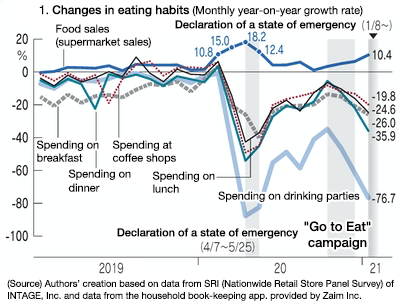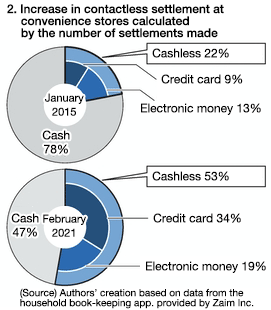In 2020, our lives have changed dramatically. In particular, from March onwards, the government requested schools to close down, businesses to adopt telework, and people to stay home, and declared a state of emergency in April. Following these measures, in May, the government called for people to practice a "new way of life," and this has led to significant changes in our purchasing behavior.
In November 2019, the Ministry of Economy, Trade and Industry (METI) developed a retail sales index using point-of-sales (POS) data provided by INTAGE Inc. (based in Chiyoda Ward, Tokyo) and GfK Marketing Services Japan Ltd.(based in Nakano Ward, Tokyo). Every Friday, METI announces the most up-to-date weekly sales trend data. This has enabled real-time tracking of changes in purchasing behavior occurring amid the COVID-19 crisis. Below, we explain our results of analysis conducted based on that data.
♦ ♦ ♦
First, in the week of the announcement of a global state of emergency (January 30, 2020) by the World Trade Organization (WHO), sales of infection prevention goods recorded explosive growth—a seven-fold expansion for face masks and a 10-fold jump for hand sanitizers—compared with the same week of the previous year. As infection prevention goods vanished from the market across the nation as a result, the government provided subsidies for private companies manufacturing those goods in order to secure stable supply, and prohibited resale of the goods. After the end of the Golden Week holiday season in early May, infection prevention goods returned to store shelves.
From the declaration of a state of emergency until mid-July, despite the fact that the number of new infection cases was held down, sales of infection prevention goods remained at a much higher level on a year-on-year basis. During the second wave of COVID-19, when the number of new infection cases surged, sales of face masks recorded the largest increase of 2020, a 19-fold jump, in the first week of August. Also, sales of hand sanitizers registered the largest growth of the year, a 22-fold leap, in the second week of the same month. Over the past year, the demand for such goods has remained high regardless of fluctuations in the number of new infection cases.
Second, as indicated by an increase in sales of personal computers and related products, telework and online conferencing have spread. Continuous increases in sales of staple and processed foods and seasonings have underscored the growing trend of eating and cooking at home, while a decline in sales of cosmetics throughout all seasons of the year indicates that people are more likely to stay at home, and even if they do go out, they wear masks.
The use of POS data and the sales index has enabled us to keep track of brick-and-mortar store sales in real time. Over the past year, we have also recognized the need for other sets of data in obtaining the full picture of changes in people's purchasing behavior. For example, we need data on people's online consumption and service consumption behavior, the diffusion of cashless settlement, and the proportion of shoppers who avoid using plastic shopping bags. Below, we look at changes in eating habits, which have been affected by restrictive measures adopted under the two declarations of a state of emergency, and the spread of cashless settlement.
Figure 1 shows that amid the COVID-19 crisis, only the value of supermarket food sales recorded year-on-year growth. As food is an everyday necessity, monthly sales usually stay stable. Sales increased 5% or more year-on-year in only five of the 84 months in the period from 2013 through 2019 and decreased 5% or more in only two. In none of the 84 months did sales increase or decrease 10% or more. Meanwhile, amid the COVID-19 crisis, in each month from February to May 2020, sales increased more than 10%, with the growth rate peaking at around 18% in April under the declaration of a state of emergency.

Let us consider the magnitude of the impact.
In the second week of October 2019, the Japan Meteorological Agency forecast that Typhoon No. 19, which was large and very powerful, would make landfall in the Kanto region in the evening of the Saturday of that week or later and pass through the Tohoku region. Railways and supermarkets in the Kanto region announced plans to suspend operations or reduce operating hours. As a result, food sales at supermarkets in the Kanto region in the second week of October grew 20% compared with the same week of the previous year. However, sales returned to normal soon after the typhoon's passage, and on a monthly basis, sales in October increased 8% year-on-year. In other words, a year-on-year increase of more than 10% in nationwide monthly sales means that people are hoarding more than what occurred just before a large typhoon.
On the other hand, regarding eating and drinking services, spending has continued to decline year-on-year for drinking parties, coffee shop visits, breakfast, lunch, and dinner amid the COVID-19 crisis. Data collected through a household bookkeeping app developed by Zaim Inc. (based in Minato Ward, Tokyo) gives us the real picture of services consumption, which cannot be captured by POS data. Zaim's data in categories of drinking parties and coffee shops can be treated as consumers' spending at eating and drinking establishments. However, the data in categories of breakfast, lunch and dinner include not only expenditure at eating and drinking establishments but also spending on foodstuffs purchased for consumption at home, including both groceries and pre-prepared meals and snacks.
The category of spending that was hit hardest during the state of emergency declaration was spending on drinking parties, which fell to a tenth of the year-before level in April, immediately after the state of emergency declaration. Spending on dinner and at coffee shops was reduced by around half. Following the state of emergency declaration, the margin of decline gradually narrowed for all categories of spending. For spending on lunch and drinking parties, the figure worsened in August, when the number of new infection cases hit the peak of the second wave of COVID-19, but it later improved at the beginning of the "Go to Eat" campaign, as was the case with other categories of spending.
However, spending on eating and drinking services continued to decline due to an increase in the number of new infection cases during the third wave of COVID-19. In January 2021, when the second declaration of a state of emergency was issued, spending dropped to 80% of the previous year level for coffee shops, to three-quarters for breakfast and lunch, to two-thirds for dinner, and to one quarter for drinking parties. While we somehow continue to eat and drink outside the home, eating-out opportunities have been reduced. By looking at both POS data and data from the household bookkeeping app, we have found increased opportunities for cooking and eating at home and spending on prepared meals purchased at shops and a decrease in spending on eating-out services.
♦ ♦ ♦
Amid the COVID-19 crisis, new shopping practices, such as body-temperature checks and hand sanitizing at store entrances, have been adopted to prevent infection. As for payment methods, cashless settlement has increased to protect store clerks and customers against the risk of infection.
Figure 2 shows a comparison between the cashless settlement rates at convenience stores in January 2015 and in February 2021 based on data provided by Zaim.

According to the Current Survey of Commerce, compiled by METI, the market size of convenience stores in 2020 was 11.6 trillion yen, second only to supermarket stores (14.8 trillion yen). According to the results of a convenience store survey in 2020 conducted by the Japan Franchise Association, individuals' annual number of store visits on an all-store basis was 15.9 billion, which means that the number of settlements made at convenience stores is tremendous.
We assume that the reason for the large spread of cashless settlement amid the COVID-19 crisis is because it provides a new added value by helping to prevent infection through the elimination of contact in the payment process, in addition to the previous benefits of improving convenience and awarding loyalty points. This is the reason that we calculated the cashless settlement rate based on the number of settlements made. In January 2015, the cashless settlement rate was 22% (the credit card settlement rate was 9% and the electronic money settlement was 13%). In February 2021, the rate was up sharply to 53% (the credit card settlement rate was 34% and the electronic money settlement rate was 19%).
While behavior patterns do not change much within just a month or so of adopting a new habit, new behavior patterns may become fixed if they continue for a year. This article confirmed that purchasing behavior for food and eating-related services has changed significantly amid the COVID-19 crisis. Regarding the spread of cashless settlements, we clarified the trend of avoiding contact as a result of using an indicator based on the number of settlements made.
Amid the COVID-19 crisis, the trends in movements of essential goods, human mobility, traffic volume, and the situation of infection have been identified based on big data, and the findings have been actively used for policy planning and management. Even after the end of the COVID-19 crisis, we hope that the government will continue to investigate the data generated by corporate activity in addition to the data available from big data service companies to keep track of data resources spread across the country. Doing so will help to improve policy quality in both normal times and emergencies in the future.
* Translated by RIETI.
April 6, 2021 Nihon Keizai Shimbun


